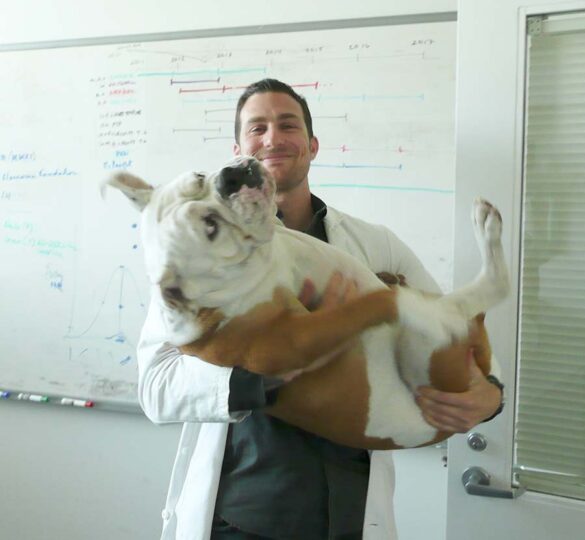Researcher Spotlight: Andrew Huberman, PhD
Researchers like Dr. Andrew Huberman and the other Catalyst for a Cure scientists are focused on stopping blindness from glaucoma.

Andrew D. Huberman, PhD, a neuroscientist at Stanford University, was a member of the Catalyst for a Cure Biomarker Initiative at the time of this 2017 interview. This unique consortium of four scientists is working collaboratively to develop new, specific and sensitive biomarkers to diagnose and manage glaucoma more effectively to preserve vision.
Thanks to the generous support of our donors, the team has made exceptional strides and recently moved their investigations from the laboratory into the clinic for further testing.
What is the primary focus of your laboratory?
My laboratory is interested in two main things. The first is to find a better way to monitor the progression of glaucoma — so we can intervene before any vision is lost. To do this we need to figure out when a patient is losing retinal ganglion cells. These neurons connect the eye to the brain but when these cells are damaged or die, vision is lost.
Our other focus is the development of new technologies to halt or reverse vision loss. My lab is investigating the biology of the ganglion cells, to examine which ones are vulnerable early in glaucoma and how best to treat them on the molecular level to keep them healthy and prevent them from dying. In addition to molecular biology and genetics of glaucoma, we are also using virtual reality and visual stimulation to keep these neurons active. Through stimulation, we are actually exercising the neurons in order to keep them healthy. We hope to even repair or regenerate some of the visual system if it is already damaged.
What has been a significant accomplishment from the Catalyst for a Cure team over the past year?
The identification of a set of neurons called the ‘off’ ganglion cell type has been extremely important in our research. These are neurons in the eye that respond to decrements in light and we have found that they are especially vulnerable at early stages of the disease. The team has developed advanced high-resolution imaging technologies and clinical tests to detect whether or not patients are losing an excessive amount of these ‘off’ ganglion cells. We think the loss of these neurons is a biomarker to determine the onset and progression of glaucoma. By targeting these cells with gene therapy and virtual reality stimulation, we hope to rescue them and prevent vision loss, perhaps even restore vision.
Our lab discovered that through visual stimulation of retinal ganglion cells, these cells can survive longer and even regenerate in the face of stress and injury. We are now using virtual reality to stimulate these neurons in a human clinical trial. This movement from the lab to testing on patients is exactly what we set out to do six years ago, when the consortium was started by Glaucoma Research Foundation.
How has the funding from Glaucoma Research Foundation impacted your work?
The Catalyst for a Cure team is immensely grateful for the Glaucoma Research Foundation’s support. It brought together scientists with different backgrounds and expertise and enabled us to work quickly and with great flexibility. Without the generous support from the donors who support GRF, this work cannot happen. The team is doing its absolute best to take these funds and use them in the most promising research projects that transition from the laboratory into the clinic. Our ultimate goal is to have new tools to help patients halt or reverse vision loss.
What are your priorities in the coming year?
The team will continue to develop and test an imaging-based biomarker that can be used in a clinical setting to enable us to understand the molecular changes to the ganglion cells, so we can detect the disease very early on. In addition, we will continue testing of visual stimulation in patients to help promote retinal ganglion cell health and regeneration.
When you’re not in the lab, how do you spend your time?
I love all animals and spend a lot of my free time with my bulldog Costello. I also spend time doing physical training such as running, martial arts, and yoga. Last year I took up diving and have traveled to do some dives with white sharks. Although it is work related, I am also writing a book on the neuroscience of vision for the general public.
What motivates and inspires you?
I am very committed to vision research. My entire career has been trying to figure out how these cells at the back of the eye, the retinal ganglion cells, develop, how they work, and how to repair them in diseases like glaucoma.
Patients are an incredible inspiration for me. My goal is to be able to help people with glaucoma preserve their vision and ultimately, to be able to restore their sight. I met a young woman at a seeing-eye dog event, Juanita Herrera, who is blind from glaucoma. She is incredibly independent, due in large part to her guide dog, and she desperately wants to help other people suffering from vision loss. It would be incredibly gratifying to be able to help patients like Juanita. The idea that there are people suffering from vision loss, to me, is a call to arms that we have to do something to reverse and cure this disease.
Posted on September 18, 2017; Reviewed on April 21, 2022